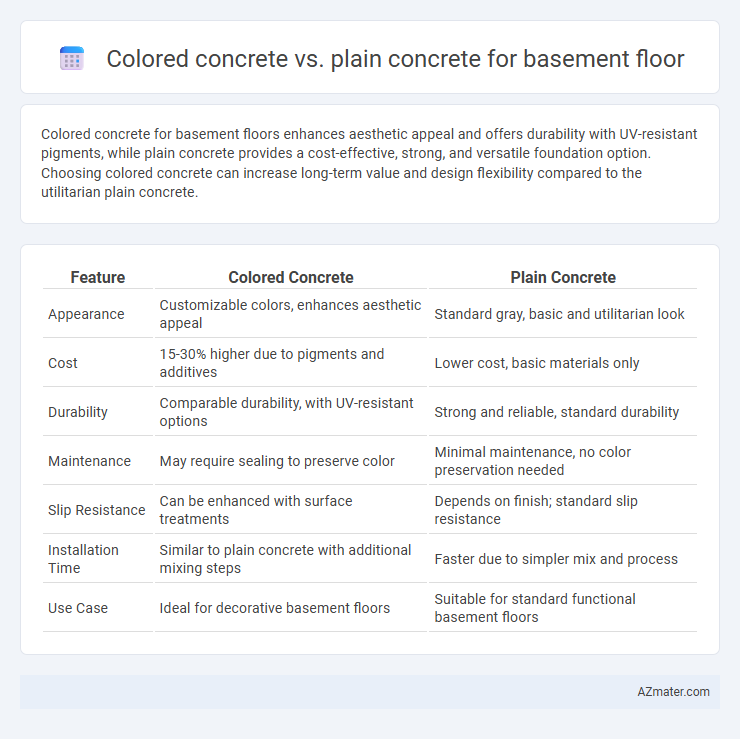Colored concrete for basement floors enhances aesthetic appeal and offers durability with UV-resistant pigments, while plain concrete provides a cost-effective, strong, and versatile foundation option. Choosing colored concrete can increase long-term value and design flexibility compared to the utilitarian plain concrete.
Table of Comparison
| Feature | Colored Concrete | Plain Concrete |
|---|---|---|
| Appearance | Customizable colors, enhances aesthetic appeal | Standard gray, basic and utilitarian look |
| Cost | 15-30% higher due to pigments and additives | Lower cost, basic materials only |
| Durability | Comparable durability, with UV-resistant options | Strong and reliable, standard durability |
| Maintenance | May require sealing to preserve color | Minimal maintenance, no color preservation needed |
| Slip Resistance | Can be enhanced with surface treatments | Depends on finish; standard slip resistance |
| Installation Time | Similar to plain concrete with additional mixing steps | Faster due to simpler mix and process |
| Use Case | Ideal for decorative basement floors | Suitable for standard functional basement floors |
Introduction to Basement Flooring Options
Colored concrete offers enhanced aesthetics and design flexibility compared to plain concrete for basement floors, allowing homeowners to customize hues and patterns that complement interior decor. Plain concrete remains a cost-effective and durable choice, providing a solid, moisture-resistant foundation essential for basement environments. Selecting between colored and plain concrete depends on budget, desired visual impact, and specific basement usage requirements.
What is Colored Concrete?
Colored concrete for basement floors is concrete mixed with pigments or stains to achieve various hues, enhancing aesthetic appeal while maintaining structural integrity. This type differs from plain concrete, which has the natural gray appearance without added colorants. Colored concrete offers durability and design flexibility, making it a popular choice for decorative basement flooring applications.
Understanding Plain Concrete
Plain concrete for basement floors offers a cost-effective and durable solution with a uniform grey appearance that resists cracking and moisture seepage when properly mixed and cured. This mixture, composed primarily of cement, water, and aggregates, provides structural strength essential for supporting basement loads without the added cost of pigments or dyes found in colored concrete. Understanding the simplicity and functional benefits of plain concrete helps homeowners prioritize durability and maintenance over aesthetic enhancements in foundational projects.
Aesthetic Appeal: Colored vs Plain Concrete
Colored concrete for basement floors enhances aesthetic appeal by offering a wide range of hues and design patterns that can complement interior decor and create a more inviting atmosphere. Plain concrete, while functional and cost-effective, often lacks visual interest and can appear dull or industrial, limiting design flexibility. Incorporating pigments or stains in colored concrete allows for customization and unique finishes that significantly elevate the basement's overall style and ambiance.
Durability and Longevity Comparison
Colored concrete for basement floors offers enhanced durability due to integral pigments that resist fading and surface wear better than plain concrete. The addition of colorants often includes chemical admixtures that improve concrete's overall strength and resistance to moisture intrusion. Plain concrete, while structurally sound, is more prone to visible wear, staining, and discoloration, leading to potentially higher maintenance over time compared to colored concrete solutions.
Cost Differences Between Colored and Plain Concrete
Colored concrete for basement floors typically costs 15% to 25% more than plain concrete due to the added expense of pigments and dyes used during mixing. The pricing difference varies based on pigment quality, color complexity, and labor, with colored concrete averaging $7 to $12 per square foot versus $5 to $8 for plain concrete. Budget considerations should also include potential long-term benefits such as reduced maintenance and enhanced aesthetic appeal that colored concrete provides over plain options.
Maintenance Requirements
Colored concrete for basement floors requires minimal maintenance, with its pigmentation helping to mask stains and reduce visible wear over time, while plain concrete often demands frequent cleaning and sealing to prevent discoloration and surface degradation. The integral color in colored concrete penetrates deeply, enhancing durability against fading, whereas plain concrete surfaces are more prone to surface blemishes and require regular resealing to maintain their appearance and structural integrity. Choosing colored concrete reduces long-term maintenance costs by minimizing the need for restorative treatments compared to plain concrete.
Installation Process and Timeframe
Colored concrete for basement floors involves mixing pigments directly into the concrete or applying stains after curing, which requires additional steps like precise color blending and curing time for optimal color setting, generally extending the installation process by 1 to 2 days. Plain concrete installation is more straightforward, focusing solely on pouring, leveling, and curing, resulting in a shorter timeframe, typically between 3 to 5 days depending on weather and slab size. The added complexity of color uniformity and sealing in colored concrete demands extra labor and drying periods, making plain concrete a quicker option for basement flooring projects.
Moisture and Stain Resistance
Colored concrete for basement floors offers enhanced stain resistance due to integral pigments that reduce surface porosity, minimizing absorption of oils, chemicals, and dirt. Plain concrete, while cost-effective, is more susceptible to moisture infiltration and staining without additional sealants or treatments. Properly sealed colored concrete provides superior protection against moisture-related issues and maintains aesthetic appeal longer in basement environments.
Choosing the Best Concrete Option for Your Basement Floor
Colored concrete for basement floors offers enhanced aesthetic appeal and customization options with pigments that resist fading and stains, making it ideal for modern, stylish interiors. Plain concrete provides a cost-effective, durable, and low-maintenance solution with excellent structural integrity and moisture resistance, essential for basement environments prone to dampness. Selecting the best option depends on budget, desired appearance, and the need for durability, with colored concrete best for design-driven projects and plain concrete suited for functional, heavy-use areas.

Infographic: Colored concrete vs Plain concrete for Basement Floor
 azmater.com
azmater.com